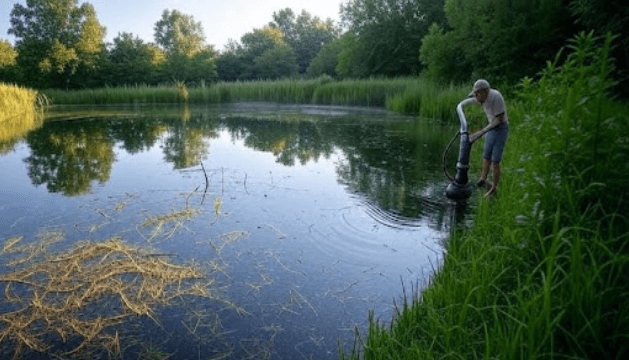How Does a Pond Vacuum Keep Your Swim Spot Sparkly Clean

A swimming pond is one of the most refreshing and eco-friendly additions to any outdoor space. Unlike conventional pools filled with chlorine and harsh chemicals, a swimming pond offers a natural, chemical-free environment that feels gentler on the skin and blends beautifully with the landscape. But keeping that water pristine isn’t as effortless as it looks. Leaves, twigs, sediment, and algae can quickly accumulate, making the water murky and less inviting. That’s why a pond vacuum is an essential tool for any pond owner who wants to enjoy a sparkling, clear swim spot without disrupting its delicate balance.
Understanding What a Swimming Pond Vacuum Is
A swimming pond vacuum is a cleaning device specifically designed to maintain the cleanliness of natural swimming ponds. Unlike traditional pool vacuums that rely on strong chemicals and mechanical filters, pond vacuums are tailored to work with organic environments. They clean away debris, sludge, and algae while keeping the ecosystem intact.
These vacuums work by using suction to draw water and debris from the pond floor and walls. The debris is collected into a container or filtration system, while clean water is returned to the pond. Models vary in complexity, ranging from simple hand-operated vacuums to advanced robotic units that clean independently.
Manual vacuums are budget-friendly but require time and effort. Semi-automatic versions combine manual guidance with enhanced suction, while robotic vacuums navigate the pond on their own, making them ideal for larger spaces. Common features include adjustable suction strength, long hoses for reaching deeper areas, and fine mesh filters capable of trapping even the smallest particles.
Why Cleaning with a Pond Vacuum Matters
Swimming ponds are designed to maintain balance through natural processes involving plants, beneficial bacteria, and biological filters. Still, outside elements like falling leaves, pollen, or soil from rain can build up over time. If not managed, this organic matter becomes food for algae and harmful bacteria. A pond vacuum steps in to prevent this cycle from spiraling out of control.
Regular use of a pond vacuum keeps the water clear and visually appealing, which is especially important if your pond is a focal point of your backyard. By reducing organic matter, it helps prevent algae blooms that can turn the water green and slimy. A vacuum also promotes safety by removing slippery sediment from the pond floor, making it safer for swimmers to walk and wade.
For those who care about sustainability, using a pond vacuum instead of chemical treatments protects beneficial organisms while keeping the environment eco-friendly. And because it helps prevent major issues before they arise, a vacuum ultimately saves both time and money on more intensive cleaning measures.
How a Pond Vacuum Works
Although the technology may seem complex, the operation of a pond vacuum is fairly straightforward. The system begins with a pump that creates suction, drawing in water along with debris and sediment. This mixture flows into a filter bag or collection chamber, where unwanted material is trapped. Clean water is either discharged back into the pond or stored separately, depending on the vacuum model.
Most vacuums are designed for maneuverability, often coming with long poles, flexible hoses, or wheels to make moving across the pond floor easier. Advanced models include features like multiple suction nozzles, adjustable power levels, and sensors that detect areas with heavier debris buildup. Robotic vacuums can even map out the pond and clean systematically, covering every corner without missing a spot.
Features to Look for When Choosing a Pond Vacuum
The right pond vacuum depends on your pond size, budget, and maintenance needs. Some of the most important features to consider include:
- Suction strength: Adjustable suction ensures you can target both fine sediment and larger debris without damaging the pond’s surface.
- Filter quality: A high-grade mesh filter prevents clogs and captures even small particles.
- Durability: Materials like stainless steel or heavy-duty plastic extend the vacuum’s lifespan and protect it from water damage.
- Ease of use: Lightweight, portable models are easier to handle, while robotic units save time with minimal manual work.
- Hose length: Long hoses are essential for deeper or larger ponds, ensuring the vacuum reaches all areas.
- Eco-conscious design: Opting for a vacuum that minimizes water waste and preserves beneficial microorganisms keeps the pond’s ecosystem in balance.
Benefits of Using a Swimming Pond Vacuum
There are many advantages to investing in a pond vacuum beyond clear water. A clean pond enhances the overall look of your outdoor space, making it a place you’ll want to spend more time in. By staying on top of maintenance, you’ll reduce the need for costly fixes like draining and refilling the pond or hiring professionals to deal with algae outbreaks.
Because pond vacuums operate without chemicals, they support eco-conscious cleaning, aligning with the philosophy of natural swimming ponds. Automated options also bring time-saving convenience, letting you enjoy your pond more and worry about cleaning less. In the long term, regular vacuuming extends the life of the pond by keeping its ecosystem balanced and preventing long-term damage from sludge buildup.
Tips for Using a Pond Vacuum Effectively
To maximize the effectiveness of your pond vacuum, it’s important to follow a few best practices. Vacuuming should be done regularly—every one to two weeks during seasons when debris accumulates most, like spring and autumn. Begin by skimming the surface with a net to remove large leaves or floating debris, preventing the vacuum from clogging.
For thorough cleaning, divide the pond into sections and work systematically. This ensures no area is overlooked, especially in larger ponds. Empty the collection chamber frequently to maintain strong suction and prevent blockages. After each cleaning session, rinse the vacuum’s filters, hoses, and nozzles to keep them in good condition and extend their lifespan.
Be mindful of water levels as well. Some vacuums discharge water outside the pond, so you may need to top it off after cleaning. And finally, always check for wear and tear—cracked hoses or worn-out filters can reduce performance and should be replaced promptly.
Choosing the Best Vacuum for Your Pond
Selecting the right vacuum starts with considering the size and depth of your pond. For smaller ponds, a manual vacuum may be sufficient and cost-effective. Larger or deeper ponds usually benefit from semi-automatic or robotic options that save time and effort.
Brand reputation also matters. Well-known manufacturers like OASE, Pondovac, and Matala are popular for their reliability and innovative designs. Reading customer reviews and comparing product specifications helps narrow down choices. If in doubt, consulting with a pond professional can provide tailored recommendations based on your unique setup.
Budget plays a role too. While manual vacuums are affordable, they require more physical work. Automatic vacuums cost more upfront but save time and reduce ongoing effort. Think about whether you prefer hands-on control or the convenience of automation.
Long-Term Impact of Regular Vacuuming
Routine vacuuming not only keeps your pond beautiful but also supports the health of the entire ecosystem. By removing organic waste, you reduce the nutrients that algae thrive on, preventing unsightly blooms. You also reduce the risk of harmful bacteria building up, creating a safer swimming environment.
Over time, this consistency leads to fewer maintenance issues and preserves the pond’s structural integrity. It also ensures the water remains enjoyable for both people and wildlife. Birds and butterflies may still visit, but without an overload of muck, frogs and pests are less likely to settle in.
Final Thoughts on Pond Vacuums
Owning a swimming pond is a rewarding experience, offering a natural retreat right in your backyard. But it comes with responsibilities, and water clarity is one of the biggest. A swimming pond vacuum is not just a luxury—it’s a necessity for anyone who wants to keep their pond safe, inviting, and eco-friendly.
Whether you choose a simple manual model or invest in a robotic cleaner, the right vacuum can transform the way you care for your pond. It reduces effort, protects the ecosystem, and allows you to spend more time enjoying the water instead of worrying about upkeep.
By making regular vacuuming part of your pond care routine, you’ll ensure your swim spot stays sparkling clean and ready to dive into at any time.
FAQs About Swimming Pond Vacuums
What’s a swimming pond vacuum?
It’s a device that removes debris, sediment, and algae from swimming ponds, keeping water clear and healthy.
How often should I vacuum my pond?
Every one to two weeks during heavy debris seasons, or as needed depending on conditions.
Will a vacuum harm the ecosystem?
No. Quality vacuums clean without disrupting beneficial bacteria or aquatic plants.
Manual vs. automatic—what’s best?
Manual is budget-friendly but requires effort. Automatic or robotic vacuums offer convenience and efficiency, especially for large ponds.
How do I choose the right vacuum?
Match it to the pond size, depth, debris type, and your budget. Prioritize strong suction, durable build, and fine filters.






